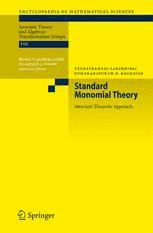Table Of ContentEncyclopaediaof MathematicalSciences
Volume137
Invariant Theoryand AlgebraicTransformation GroupsVIII
SubseriesEditors:
RevazV.Gamkrelidze VladimirL.Popov
Venkatramani Lakshmibai
Komaranapuram N. Raghavan
Standard
Monomial Theory
Invariant Theoretic Approach
VenkatramaniLakshmibai KomaranapuramN.Raghavan
DepartmentofMathematics InstituteofMathematicalSciences
NortheasternUniversity,Boston02115 C.I.T.Campus,Taramani
USA Chennai,600113
e-mail:[email protected] INDIA
e-mail:[email protected]
FoundingeditoroftheEncyclopaediaofMathematicalSciences:RevazV.Gamkrelidze
ISBN978-3-540-76756-5 e-ISBN978-3-540-76757-2
DOI10.1007/978-3-540-76757-2
EncyclopaediaofMathematicalSciencesISSN0938-0396
LibraryofCongressControlNumber:2007939889
MathematicsSubjectClassification(2000):13F50,14M12,14M15,14M17,14L35
(cid:2)c 2008Springer-VerlagBerlinHeidelberg
Thisworkissubjecttocopyright.Allrightsarereserved,whetherthewholeorpartofthematerialis
concerned,specificallytherightsoftranslation,reprinting,reuseofillustrations,recitation,broadcasting,
reproductiononmicrofilmorinanyotherway,andstorageindatabanks.Duplicationofthispublication
orpartsthereofispermittedonlyundertheprovisionsoftheGermanCopyrightLawofSeptember9,
1965,initscurrentversion,andpermissionforusemustalwaysbeobtainedfromSpringer.Violationsare
liabletoprosecutionundertheGermanCopyrightLaw.
The use of general descriptive names, registered names, trademarks, etc. in this publication does not
imply,evenintheabsenceofaspecificstatement,thatsuchnamesareexemptfromtherelevantprotective
lawsandregulationsandthereforefreeforgeneraluse.
Coverdesign:WMXDesignGmbH,Heidelberg,Germany
Printedonacid-freepaper
9 8 7 6 5 4 3 2 1
springer.com
Tothememoryof
Professor C.Musili
Preface
ThegoalofthisbookistopresenttheresultsofClassicalInvariantTheory(abbrevi-
atedCIT)andthoseofStandardMonomialTheory(abbreviatedSMT)insuchaway
astobringouttheconnectionbetweenthetwotheories.Eventhoughtherearemany
recent books on CIT, e.g., [25,35,53,97,99], none of them discusses SMT: there
is but only a passing mention of the main papers of SMT towards the end of [53].
Detailsabouttheconnectionarealsonottobefoundinthecomprehensivetreatment
ofSMT[59]thatisinpreparation.Hencetheneedwasfeltforabookthatdescribes
insomedetailthisnaturalandbeautifulconnection.
After presenting SMT for Schubert varieties—especially, for those in the ordi-
nary,orthogonal,andsymplecticGrassmannians—itisshown(usingSMT)thatthe
categoricalquotientsappearinginCITmaybeidentifiedas“suitable”opensubsets
of certain Schubertvarieties.Similar results are presentedfor certaincanonicalac-
tionsofthespeciallinearandspecialorthogonalgroups.Wehavealsoincludedsome
importantapplicationsofSMT:tothedeterminationofsingularlociofSchubertva-
rieties, to the study of some affine varieties related to Schubert varieties—ladder
determinantalvarieties,quivervarieties,varietyofcomplexes,etc.—andtotoricde-
generationsofSchubertvarieties.
Prerequisiteforthisbookissomefamiliaritywithcommutativealgebra,algebraic
geometry and algebraic groups. A basic reference for commutative algebra is [27],
for algebraic geometry [37], and for algebraic groups [7]. We have also included a
briefreviewofGIT(geometricinvarianttheory),areferenceforwhichis[87](and
also[96]).
Wehavemostlyusedstandardnotationandterminology,andhavetriedtokeep
notationto a minimum.Throughoutthe book,we havenumberedTheorems, Lem-
mas, Propositions etc., in order according to their section and subsection; for ex-
ample, 3.2.4 refers to fourth item in the second subsection of third section of the
presentchapter.Thechapternumberisalsomentionediftheitemappearsinanother
chapter.
ThisbookmaybeusedforayearlongcourseoninvarianttheoryandSchubert
varieties.Thematerialcoveredinthisbookshouldprovideadequatepreparationfor
VIII Preface
graduate students and researchers in the areas of algebraic geometry and algebraic
groupstoworkonopenproblemsintheseareas.
A Homage & an acknowledgement: In the original plan for this book, Musili
was one of the co-authors. Unfortunately, Musili passed away suddenly on Oct 9,
2005.WededicatethisbooktothememoryofMusili.Wealsowouldliketothank
Ms. Bhagyavati (Musili’s wife) and Ms. Lata (Musili’s daughter) for providing us
withthefilesthatMusilihadprepared.
Wewishtothanktherefereesfortheircomments.
Boston,Trieste V.Lakshmibai
October2007 K.N.Raghavan
Contents
1 Introduction................................................... 1
1.1 Thesubjectmatterinanutshell............................... 1
1.1.1 WhatisCIT?........................................ 1
1.1.2 WhatisSMT?....................................... 2
1.1.3 TheSMTapproachtoCIT ............................ 2
1.2 Thesubjectmatterindetail .................................. 2
1.2.1 ProofbytheSMTapproach ........................... 3
1.2.2 SL (K),SO (K)actions ............................. 5
n n
1.3 Whythisbook? ............................................ 6
1.4 AbriefhistoryofSMT...................................... 7
1.5 SomefeaturesoftheSMTapproach........................... 7
1.6 Theorganizationofthebook ................................. 9
2 Generalitiesonalgebraicvarieties................................ 11
2.1 Somebasicdefinitions ...................................... 11
2.2 Algebraicvarieties ......................................... 12
2.2.1 Affinevarieties ...................................... 12
3 Generalitiesonalgebraicgroups ................................. 17
3.1 Abstractrootsystems ....................................... 17
3.2 Rootsystemsofalgebraicgroups ............................. 19
3.2.1 Linearalgebraicgroups ............................... 19
3.2.2 Parabolicsubgroups.................................. 21
3.3 Schubertvarieties .......................................... 22
3.3.1 WeylandDemazuremodules .......................... 24
3.3.2 LinebundlesonG/Q ................................ 25
3.3.3 EquationsdefiningaSchubertvariety ................... 27
4 Grassmannian ................................................. 29
4.1 ThePlückerembedding ..................................... 29
4.1.1 ThepartiallyorderedsetI .......................... 30
d,n
X Contents
4.1.2 PlückerembeddingandPlückercoordinates.............. 30
4.1.3 Plückerquadraticrelations ............................ 31
4.1.4 Moregeneralquadraticrelations ....................... 32
(cid:2)
4.1.5 TheconeG overG .............................. 33
d,n d,n
4.1.6 IdentificationofG/P withG ....................... 33
d d,n
4.2 SchubertvarietiesofG ................................... 34
d,n
4.2.1 Bruhatdecomposition ................................ 34
4.2.2 DimensionofX ..................................... 35
i
4.2.3 FurtherresultsonSchubertvarieties .................... 35
4.3 StandardmonomialtheoryforSchubertvarietiesinG ......... 36
d,n
4.3.1 Standardmonomials.................................. 36
4.3.2 Linearindependenceofstandardmonomials ............. 36
4.3.3 Generationbystandardmonomials ..................... 37
4.3.4 EquationsdefiningSchubertvarieties ................... 38
4.4 StandardmonomialtheoryforaunionofSchubertvarieties ....... 39
4.4.1 Linearindependenceofstandardmonomials ............. 39
4.4.2 Standardmonomialbasis.............................. 39
4.4.3 Consequences ....................................... 40
4.5 Vanishingtheorems......................................... 41
4.6 ArithmeticCohen-Macaulayness,normalityandfactoriality....... 44
4.6.1 FactorialSchubertvarieties............................ 46
5 Determinantalvarieties ......................................... 47
5.1 Recollectionoffacts ........................................ 47
5.1.1 EquationsdefiningSchubertvarietiesintheGrassmannian . 48
5.1.2 EvaluationofPlückercoordinatesontheoppositebigcell
inG ............................................. 48
d,n
5.1.3 IdealoftheoppositecellinX(w) ...................... 49
5.2 Determinantalvarieties...................................... 49
5.2.1 ThevarietyD ...................................... 49
t
5.2.2 IdentificationofD withY ........................... 49
t φ
5.2.3 Thebijectionθ ...................................... 51
5.2.4 Thepartialorder(cid:2)................................... 51
5.2.5 Cogenerationofanideal .............................. 52
5.2.6 Themonomialorder≺andGröbnerbases ............... 53
6 SymplecticGrassmannian....................................... 55
6.1 SomebasicfactsonSp(V) .................................. 56
6.1.1 SchubertvarietiesinG/B ............................ 59
G
6.2 ThevarietyG/P .......................................... 60
n
−
6.2.1 IdentificationofSymM withO ...................... 61
n G
6.2.2 Canonicaldualpair .................................. 62
6.2.3 Thebijectionθ ...................................... 62
6.2.4 ThedualWeylG-modulewithhighestweightω ......... 63
n
6.2.5 IdentificationofD (SymM )withY (ϕ)............... 64
t n Pn
Contents XI
6.2.6 Admissiblepairsandcanonicalpairs.................... 65
6.2.7 Canonicalpairs...................................... 65
6.2.8 Theinclusionη:In,2n (cid:7)→WPn ×WPn.................. 66
6.2.9 AstandardmonomialbasisforD (SymM ) ............. 67
t n
6.2.10 DeConcini-Procesi’sbasisforD (SymM ) ............. 68
t n
7 OrthogonalGrassmannian ...................................... 71
7.1 TheevenorthogonalgroupSO(2n) ........................... 71
7.1.1 SchubertvarietiesinG/B ............................ 74
G
7.2 ThevarietyG/P .......................................... 77
n
−
7.2.1 IdentificationofSkM withO ....................... 78
n G
7.2.2 Canonicaldualpair .................................. 78
7.2.3 Thebijectionθ ...................................... 79
7.2.4 ThedualWeylG-modulewithhighestweightω ......... 79
n
7.2.5 IdentificationofD (SkM )withY (ϕ) ................. 80
t n G
7.2.6 AstandardmonomialbasisforD (SkM )............... 82
t n
8 Thestandardmonomialtheoreticbasis ........................... 85
8.1 SMTfortheevenorthogonalGrassmannian .................... 86
8.2 SMTforthesymplecticGrassmannian......................... 89
9 ReviewofGIT ................................................. 95
9.1 G-spaces.................................................. 95
9.1.1 Reductivegroups .................................... 95
9.2 Affinequotients............................................ 98
9.2.1 Affineactions ....................................... 99
9.3 Categoricalquotients ....................................... 101
9.3.1 Examples........................................... 102
9.4 Goodquotients ............................................ 103
9.4.1 Someresultsongoodquotients ........................ 105
9.5 Stableandsemi-stablepoints................................. 108
9.5.1 Stable,semistable,andpolystablepoints................. 108
9.5.2 Othercharacterizationsofstability,semistability .......... 110
9.6 Projectivequotients......................................... 114
9.7 L-linearactions ............................................ 117
9.8 Hilbert-Mumfordcriterion ................................... 117
10 Invarianttheory ............................................... 121
10.1 Preliminarylemmas ........................................ 121
10.2 SL (K)-action ............................................ 124
d
10.2.1 Thefunctionsf ..................................... 124
τ
10.2.2 Thefirstandsecondfundamentaltheorems............... 126
10.3 GL (K)-action: ........................................... 128
n
10.3.1 Thefirstandsecondfundamentaltheorems............... 129
10.4 O (K)-action.............................................. 132
n
XII Contents
10.5 Sp (K)-action ............................................ 136
2(cid:9)
11 SL (K)-action................................................. 137
n
11.1 Quadraticrelations ......................................... 138
11.1.1 ThepartiallyorderedsetH .......................... 139
r,d
11.2 TheK-algebraS ........................................... 140
11.2.1 TheSL (K)-action .................................. 141
n
11.3 StandardmonomialsintheK-algebraS........................ 142
11.3.1 Quadraticrelations................................... 143
11.3.2 Linearindependenceofstandardmonomials ............. 145
11.3.3 ThealgebraS(D).................................... 146
11.3.4 AstandardmonomialbasisforR(D) ................... 148
11.3.5 StandardmonomialbasesforM(D),S(D)............... 149
11.4 NormalityandCohen-MacaulaynessoftheK-algebraS .......... 150
11.4.1 Thealgebraassociatedtoadistributivelattice ............ 150
11.4.2 FlatdegenerationsofcertainK-algebras................. 151
11.4.3 ThedistributivelatticeD.............................. 152
11.4.4 FlatdegenerationofSpecR(D)tothetoricvariety
SpecA(D).......................................... 154
11.5 TheringofinvariantsK[X]SLn(K) ............................ 155
12 SO (K)-action ................................................ 159
n
12.1 Preliminaries .............................................. 160
12.1.1 TheLagrangianGrassmannianvariety................... 161
12.1.2 SchubertvarietiesinL .............................. 161
m
12.1.3 TheoppositebigcellinL ............................ 162
m
−
12.1.4 Thefunctionsf onO ............................. 163
τ,ϕ G
12.1.5 TheoppositecellinX(w)............................. 164
12.1.6 Symmetricdeterminantalvarieties ...................... 164
12.1.7 ThesetH ......................................... 165
m
12.2 ThealgebraS.............................................. 167
12.2.1 Standardmonomialsandtheirlinearindependence ........ 168
12.2.2 Linearindependenceofstandardmonomials ............. 169
12.3 ThealgebraS(D) .......................................... 169
12.3.1 Quadraticrelations................................... 170
12.3.2 AstandardmonomialbasisforR(D) ................... 171
12.3.3 StandardmonomialbasesforS(D) ..................... 172
12.4 Cohen-MacaulaynessofS ................................... 173
12.4.1 AdosetalgebrastructureforR(D) ..................... 175
12.5 TheequalityRSOn(K) =S ................................... 176
12.6 Applicationtomoduliproblem ............................... 180
12.7 ResultsfortheadjointactionofSL (K) ....................... 181
2

